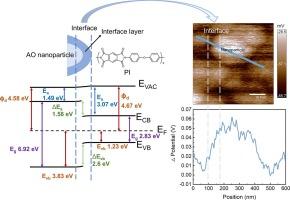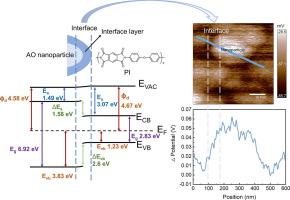Enhancing high-temperature capacitor performance of alumina-polyimide nanocomposites induced by the microscopic interface charge trap
IF 6.9
2区 材料科学
Q2 CHEMISTRY, PHYSICAL
引用次数: 0
Abstract
Nanofillers and polymer matrices are utilized to construct nanocomposites, offering a promising approach to enhance energy storage performance in harsh conditions. This strategy relies on structural design to introduce deep charge traps that regulate carrier transport within the material. However, comprehensive studies combining theoretical and experimental methods to elucidate how trap introduction by nanofillers improves capacitive performance remain limited. Here, we in-situ synthesized alumina (AO) nanosheets via a hydrothermal method and fabricated uniformly dispersed nanocomposites with polyimide (PI) as the matrix. Energy band theory revealed that AO nanosheets introduced deep charge traps at the PI-AO interface, substantially reducing leakage current density. High-resolution Kelvin probe force microscopy (KPFM) experimentally confirmed the presence of interfacial deep charge traps at the nanofiller/polymer interface. Thermally stimulated discharge current (TSDC) was further measured to characterize variations in trap depth and density among different materials. At 150 °C, the optimized nanocomposite achieved a high energy storage density of 2.72 J cm−3 with a charge–discharge efficiency exceeding 90 %, corresponding to approximately 448 % of the performance of pristine PI. This work bridges critical gaps between experimental observations and theoretical mechanisms, clarifying the role of interfacial charge traps in nanocomposite performance.


微观界面电荷阱诱导氧化铝-聚酰亚胺纳米复合材料增强高温电容器性能
利用纳米填料和聚合物基质来构建纳米复合材料,为提高恶劣条件下的储能性能提供了一种有前途的方法。这种策略依赖于结构设计来引入深层电荷陷阱,以调节材料内部的载流子传输。然而,结合理论和实验方法来阐明纳米填料引入陷阱如何改善电容性能的综合研究仍然有限。本文采用水热法原位合成氧化铝(AO)纳米片,并以聚酰亚胺(PI)为基体制备了均匀分散的纳米复合材料。能带理论表明,AO纳米片在PI-AO界面引入了深度电荷阱,大大降低了泄漏电流密度。高分辨率开尔文探针力显微镜(KPFM)实验证实了在纳米填料/聚合物界面上存在界面深电荷阱。进一步测量了热激发放电电流(TSDC),以表征不同材料之间陷阱深度和密度的变化。在150 °C下,优化后的纳米复合材料的储能密度达到2.72 J cm−3,充放电效率超过90 %,相当于原始PI的448 %。这项工作弥合了实验观察和理论机制之间的关键差距,阐明了界面电荷陷阱在纳米复合材料性能中的作用。
本文章由计算机程序翻译,如有差异,请以英文原文为准。
求助全文
约1分钟内获得全文
求助全文
来源期刊

Applied Surface Science
工程技术-材料科学:膜
CiteScore
12.50
自引率
7.50%
发文量
3393
审稿时长
67 days
期刊介绍:
Applied Surface Science covers topics contributing to a better understanding of surfaces, interfaces, nanostructures and their applications. The journal is concerned with scientific research on the atomic and molecular level of material properties determined with specific surface analytical techniques and/or computational methods, as well as the processing of such structures.
 求助内容:
求助内容: 应助结果提醒方式:
应助结果提醒方式:


